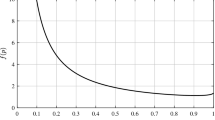Abstract
Under some restriction, we establish the minimum volume confidence region for parameters of Pareto distribution, which can be applied to complete samples and, as well as left, right or doubly censored samples. It is not only computationally convenient, but also almost as accurate as the best confidence region in the literature, the computation of which is difficult in the double or left censoring case.


Similar content being viewed by others
References
Abdel-Ghaly AA, Attia AF, Ali HM (1998) Estimation of the parameters of Pareto distribution and the reliability function using accelerated life testing with censoring. Commun Stat Simul Comput 27:469–484
Arnold BC (1983) Pareto distributions. International Cooperative Publishing House, Fairland
Beirlant J, Teugels JL, Vynckier P (1996) Practical analysis of extreme values. Leuven University Press, Leuven
Bickel PJ, Doksum KA (2001) Mathematical statistics: basic ideas and selected topics, vol I, 2nd edn. Prentice Hall, New Jersey
Brazauskas V, Serfling R (2005) Favorable estimators for fitting Pareto models. Astin Bull 33:365–381
Chen Z (1996) Joint confidence region for the parameter of Pareto distribution. Metrika 44:191–197
David HA, Nagaraja HN (2003) Order statistics, 3rd edn. Wiley, Hoboken
Dyer D (1981) Structural probability bounds for the strong Pareto distribution. Can J Stat 9:71–77
Fahidy TZ (2011) Applying Pareto distribution theory to electrolytic powder production. Electrochem Commun 13:262–264
Fernández AJ (2008) Highest posterior density estimation from multiply censored Pareto data. Stat Pap 49:333–341
Fernández AJ (2012) Minimizing the area of a Pareto confidence region. Eur J Oper Res 221:205–212
Fernández AJ (2013) Smallest Pareto confidence regions and applications. Comput Stat Data Anal 62:11–25
Fernández AJ (2014) Computing optimal confidence sets for Pareto models under progressive censoring. J Comput Appl Math 259:168–180
Hong CW, Wu JW, Cheng CH (2008) Computational procedure of performance assessment of lifetime index of Pareto lifetime businesses based on confidence interval. Appl Soft Comput 8:698–705
Howlader HA, Hossain A (2002) Bayesian survival estimation of Pareto distribution of the second kind based on failure-censored data. Comput Stat Data Anal 38:301–314
Ijiri Y, Simon HA (1975) Some distributions associated with Bose-Einstein statistics. Proc Natl Acad Sci 72:1654–1657
Johnson NL, Kotz S, Balakrishnan N (1994) Continuous univariate distributions, vol 1, 2nd edn. Wiley, New York
Kim JHT, Ahn S, Ahn S (2017) Parameter estimation of the Pareto distribution using a pivotal quantity. J Korean Stat Soc 46:438–450
Kuş C, Kaya MF (2007) Estimation for the parameters of the Pareto distribution under progressive censoring. Commun Stat 36:1359–1365
Nigm AM, Al-Hussaini EK, Jaheen ZF (2003) Bayesian one-sample prediction of future observation under pareto distribution. Statistics 37:527–536
Pareto V (1897) Couts d’economie politique. Rouge and cie, Lausanne and Paris
Parsi S, Ganjali M, Sanjari Farsipour N (2010) Simultaneous confidence intervals for the parameters of Pareto distribution under progressive censoring. Commun Stat 39:94–106
R Core Team (2014) R: a Language and environment for statistical computing, R foundation for statistical computing, Vienna. http://www.R-project.org/
Reed WJ, Jorgensen M (2004) The double Pareto-lognormal distributiona new parametric model for size distributions. Commun Stat 33:1733–1753
Seal HL (1980) Survival probabilities based on Pareto claim distributions. Astin Bull 11:61–72
Soliman AA (2008) Estimations for Pareto model using general progressive censored data and asymmetric loss. Commun Stat 37:1353–1370
Upadhyay SK, Shastri V (1997) Bayesian results for classical Pareto distribution via Gibbs sampler, with doubly-censored observations. IEEE Trans Reliab 46:56–59
William J Reed (2003) The Pareto law ofincomesan explanation and an extension. Physica 319:469–486
Wu SF (2008) Interval estimation for a Pareto distribution based on the doubly Type II censored sample. Comput Stat Data Anal 52:3779–3788
Wu SF (2010) Interval estimation for the Pareto distribution based on the progressive type II censored sample. J Stat Comput Simul 80:463–474
Wu JW, Lee WC, Chen SC (2006) Computational comparison for weighted moments estimators and BLUE of the scale parameter of a Pareto distribution with known shape parameter under type II multiply censored sample. Appl Math Comput 181:1462–1470
Wu JW, Lee WC, Chen SC (2007) Computational comparison of prediction future lifetime of electronic components with Pareto distribution based on multiply type II censored samples. Appl Math Comput 184:374–406
Zhang J (2013) Simplification of joint confidence regions for the parameters of the Pareto distribution. Comput Stat 28:1453–1462
Zhang J (2017a) Minimum-volume confidence sets for exponential distributions. The American Statistician (in press)
Zhang J (2017b) Minimum-volume confidence sets for parameters of normal distributions. AStA Adv Stat Anal 101:309–320
Acknowledgements
This research is partially supported by the National Natural Science Foundation of China (NSFC, Grant No. 11561073). The author would like to thank Editors and anonymous referees for valuable comments, corrections and suggestions.
Author information
Authors and Affiliations
Corresponding author
Appendices
Appendix A: Proof of Theorem 1
Proof
Let \(C^T\) be any level \(1-\alpha \) confidence set of \(\theta \), satisfying \({\int }_{\theta \in C^t}~dt\le r_k(\theta )|C^\theta |\). Then for any \(\theta \in \Theta \),
It follows from \(P[\theta \in C^T_k]=1-\alpha \) that
where
by definition of \(C^T_k\), and \(\overline{C}\) denotes the complementary set of C. Thus, \(|C_k^\theta |\le |C^\theta |\) for \(\theta \in \Theta \), which implies that \(|C^T_k|\le |C^T|\). The proof is complete. \(\square \)
Appendix B: R code for computing \(k_{\alpha },\ k_1,\ k_2,\ k_1(x),\ k_2(x) \) in (4) and (5)

Rights and permissions
About this article
Cite this article
Jiang, F., Zhou, J. & Zhang, J. Restricted minimum volume confidence region for Pareto distribution. Stat Papers 61, 2015–2029 (2020). https://doi.org/10.1007/s00362-018-1018-9
Received:
Revised:
Published:
Issue Date:
DOI: https://doi.org/10.1007/s00362-018-1018-9




